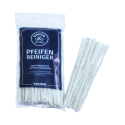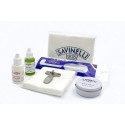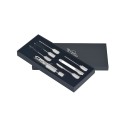How to clean a Tobacco Pipe?
CLICK HERE FOR HIGH-QUALITY PIPE CLEANERS AT AFFORDABLE PRICES
After each smoke, the tobacco pipe should be cleaned.
This step, part of “regular maintenance”, ensures the tobacco pipe is in optimal condition for enjoying our favorite tobaccos without altering their flavor.
How to Clean a Tobacco Pipe with Alcohol
Sometimes, using a tobacco pipe cleaner is not enough, and a deeper cleaning may be necessary.
In this case, clean the inside of the mouthpiece and shank by soaking the tobacco pipe cleaner in denatured alcohol or similar products for a more thorough cleaning.
However, this practice should not be done routinely but only when you notice alterations in the tobacco’s flavor, such as bitter or unpleasant notes.
Cleaning a Tobacco Pipe with Whisky
When Fabio began this work over 30 years ago, a common practice was to soak a tobacco pipe, even a new one, in a spirit (usually whiskey or cognac). Pipe smokers claimed this would make the smoke unique.
In reality, this procedure should be avoided at all costs. Soaking an artisan tobacco pipe in an alcohol-containing liquid expands the briar's pores. These pores play a crucial role in cooling the bowl by transferring heat from the inside to the outside.
The result is a tobacco pipe that overheats significantly, negatively impacting the tobacco's flavor.
How to Use a Tobacco Pipe Cleaner?
After finishing your smoke, allow the tobacco pipe to cool.
Next, disassemble the mouthpiece and run the tobacco pipe cleaner, through the latter and the shank.
This removes tobacco and tarry residues. Use the same tobacco pipe cleaner to clean the inner walls of the bowl, removing combustion ash without damaging the protective carbon layer.
If the tobacco pipe produces moisture during smoking, it may be helpful to insert a tobacco pipe cleaner into the shank after cleaning to absorb the moisture and help the pipe dry faster.
Deep Cleaning a Tobacco Pipe
After many smokes, a carbon layer forms inside the bowl. This layer protects the bowl but thickens over time, making it necessary to reduce its diameter.
When the thickness reaches 1.5 mm to 2.0 mm, it’s advisable to trim it using specialized reamers.
Reamers are available in fixed diameters for experienced tobacco pipe smokers and adjustable diameters, which are easier to use. Precision is crucial when using a reamer, as improper use can damage the protective layer.
What to Do When the Pipe Loses Its Shine
Over time and with repeated use, the tobacco pipe’s briar tends to lose its luster, especially if it has a smooth finishing.
A practical solution is using products designed to restore shine, which also help remove the yellowing that can appear on ebonite stems over time.
We emphasize that while smoking may reduce a tobacco pipe’s shine, it highlights its unique and inimitable nuances, especially in highly grained tobacco pipes, where the flame’s contrast becomes more pronounced.
Remember: Every pipe is unique, just like the smoking experience it provides.
HOW TO POLISH YOUR TOBACCO PIPE? CLICK HERE FOR OUR GUIDE
How to Clean Your Tobacco Pipe: Tutorial









By Paolo Gasparini 02/17/2025 12:21:35
Vorrei imparare